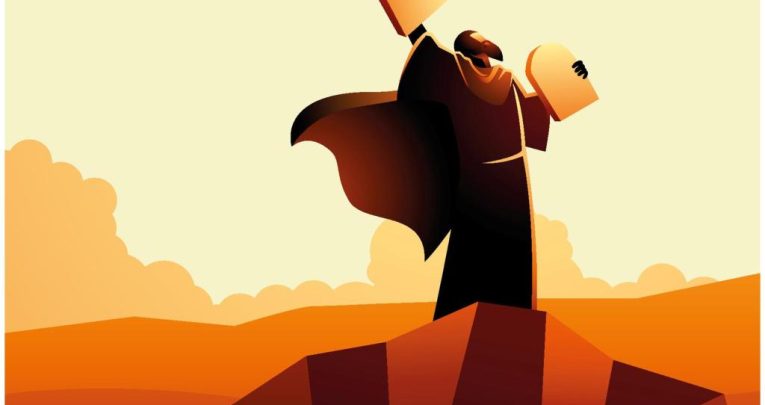Why the Bible can be a valuable source of inspiration for literacy teaching

The Bible can represent a valuable source of inspiration for literacy teaching, says Andrew Prichard – especially if we take time to consider the whole story…

- by Andrew Prichard
- Teacher and author of The Blockbuster Bible

“I always think that if an alien came down and you were the only person they met, and they said, ‘What’s life about? What’s earth about? Tell us everything,’ and you said, ‘Well, there’s a book here that purports to tell you everything. Some people believe it to be true; some people [do] not believe it [to be] true.’ ‘Wow, what’s it like?’ and you go, ‘I don’t know, I’ve never read it.’ It would be an odd thing wouldn’t it?”
So said author-comedian Lee Mack (BBC’s Not Going Out), when interviewed for R4’s Desert Island Discs. And it’s a fair point.
Why does the Bible matter, and how can we all benefit from it – including when it comes to supporting our literacy teaching?
Well, surely the bestselling book of all time – over 6 billion copies – can relevantly inform how we and children engage with sources first-hand? It’s a book and worldview that has shaped history, and the cross-curricular links are obvious
Ofsted recently expressed concern that RE is often isolated from the rest of the curriculum; using the Bible to teach literacy could help to address this.
The challenge for teachers is not just to use the Bible for literacy teaching; but to do it well. In our busy, Google-dependent and often divided society, we need to dig deep so as not to ‘dumb it down’.
In a survey, 40% of people agreed that the Bible is an influence for good in society, and even the atheist writer Philip Pullman campaigns to retain the teaching of biblical stories alongside popular folk-tales.
There are treasures in the Bible that can inform more than our RE teaching alone, and the investment is worth it.
Common language
Culture expects a level of Biblical literacy. We are expected to understand ‘David and Goliath contests’, and references to tasks ‘as hard as walking on water’ and floods ‘of biblical proportions’.
Advertisers often use allusions to temptation that involve a woman and a snake in a garden.
The Bible is not dead, and its rich use of literary devices and complex storytelling makes it an excellent teaching resource.
Consider the reversal of fortunes found in the tale of Daniel and the lions’ den. Or the promise-fulfilment narratives, like Abraham’s search for a wife for his son. Or passages dripping with irony, like when the crowds call for Jesus to save them by coming down from the cross.
And it’s important to use the original text or something close to it – this is where the juice is found. Great literature evokes great emotions, and the Bible, describing itself as sweeter than honey, is no different.
But here’s the nub: it’s not enough simply to teach the texts on their own.
It’s important to engage with the story behind the stories. CS Lewis based The Chronicles of Narnia on a complete view of the Bible. While characters like Aslan and Peter mirror Jesus and, well, Peter, his created world mirrors the biblical meta-narrative.
Teachers need to take Eve out of Eden and consider the concept of sin across all Bible characters. They need to see Abraham not simply in Genesis, but every place where God fulfils the Abrahamic Covenant.
Often people call this biblical theology: seeing the big story through scripture. And therefore the challenge for teachers is to see and explain the storylines that link this text that was written over 1,600 years ago – the ideas of living with God, God’s promises, and God’s rescue.
Follow the map
This is what led me to write The Blockbuster Bible: The Teacher’s Cut. It’s my ‘toe in the water’ (cf Peter) to help children and teachers see the story behind the stories.
In the end, however, teachers do need to explore the original text (or something very close), and avoid passing on a second-hand knowledge of them. Not doing so is like reading about Dahl’s James and the Giant Peach before teaching it, but not reading the book itself. Which is bananas (or peaches).
Writing is so personal, so creative. So enjoyable! And using the Bible as a resource offers teachers the chance to open children’s minds to a wide range of writing styles (eg poetry, prose, journalistic reporting, and modern rap), that they can use as they engage with the content.
The original text is a map that enables us to explore millennia of history, and minds which shaped culture; let’s get back to it.
Try it today: 5 ways to boost literacy with the Bible
1 | Tap into popular expressions
Create a display of biblical expressions that we use today – for example, ‘The writing’s on the wall’ (cf Daniel), or ‘Oh ye of little faith!’ (cf Jesus) – and talk about the stories from which they come, and how the meaning has developed over time.
2 | Go visual
Pictures give great stimulus material. Start a lesson by looking at an image of Eve in the Garden, and asking ‘Who, What, Why, Where, When’ questions, leading to a piece of writing that could later be compared with a Bible story.
3 | Look at meta-narratives
What’s the big story behind any story? Can your pupils tell a tale in just ten words? Or seven? What if you give them a prompt (e.g. heroes, enemies, problems and solutions)?
4 | Build links across stories
The Bible is full of promises and fulfilments, flashbacks and flash-forwards. Talk about how God fulfils his promises to Abraham, in preparation for the children writing stories that feature ideas or problems to be resolved later.
5 | Get descriptive
A pacey plot is great, but it’s also good to slow down and pore over the details sometimes. I love how Genesis 24 (the longest chapter in Genesis) ekes out the story of a servant’s search for a wife for Abraham’s son Isaac. Share it with your pupils, and copy at will!
Andrew Prichard is a teacher, and author of The Blockbuster Bible and companion book The Blockbuster Bible: The Teacher’s Cut (Lion Children’s Books).










